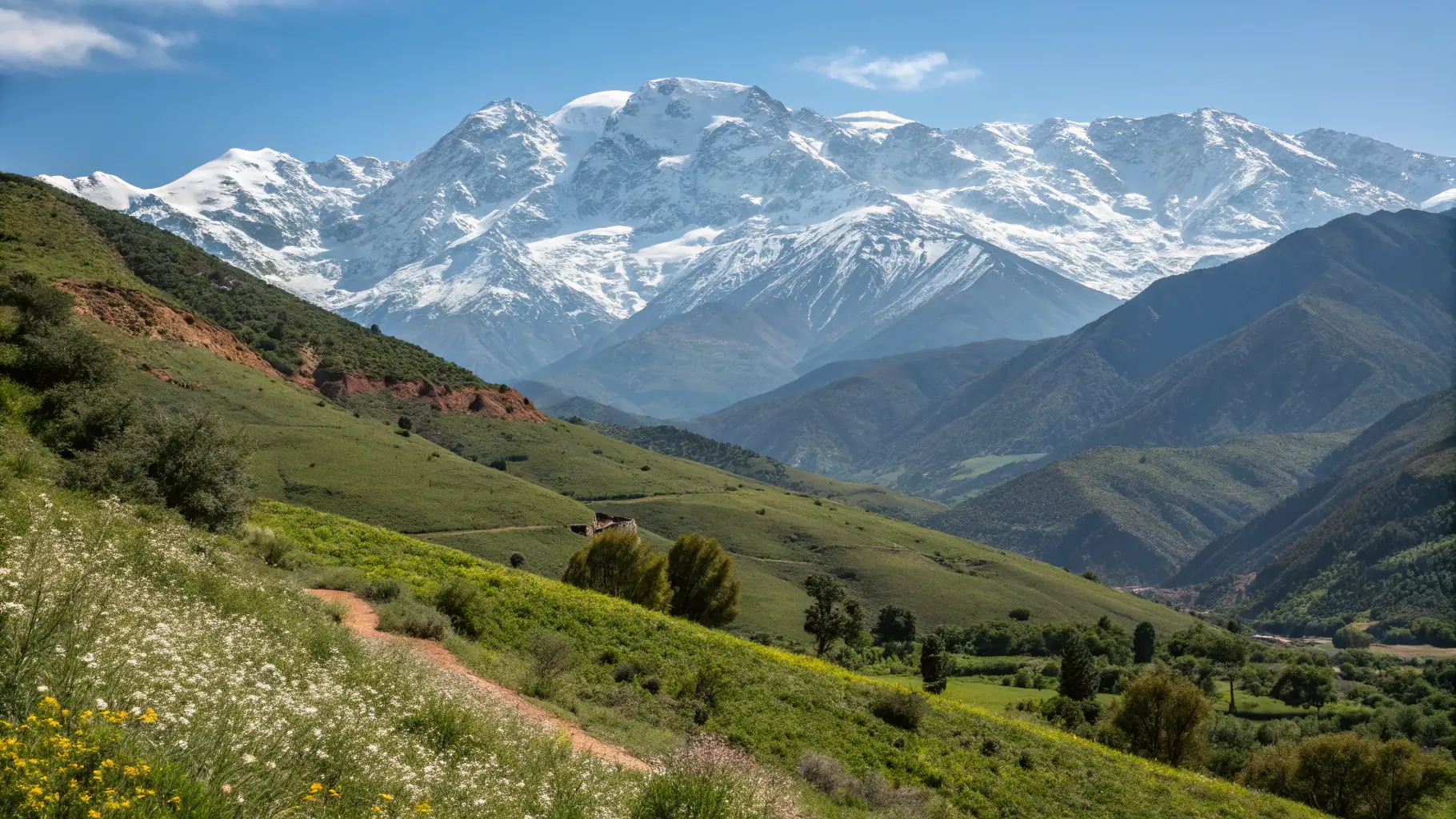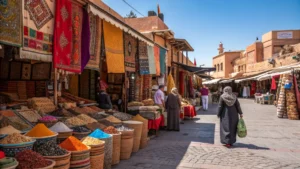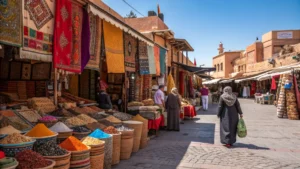The Atlas Mountains, a majestic range in Morocco, offer a plethora of hiking trails for all levels of experience. From challenging climbs to leisurely strolls, the mountains provide a unique opportunity to connect with nature. Explore the diverse landscapes of the Atlas Mountains. Discover hidden valleys, lush forests, and breathtaking vistas. The mountains offer a unique opportunity to immerse yourself in the beauty of nature. Whether you’re an experienced hiker or a beginner, the Atlas Mountains have something to offer. Plan your trip carefully, considering the weather conditions and the difficulty of the trails. Enjoy the tranquility and beauty of the mountains.
The Atlas Mountains, stretching 1,600 miles across Morocco, Algeria, and Tunisia, offer some of North Africa’s most spectacular hiking experiences. This ancient mountain range, with peaks soaring above 13,000 feet, presents diverse landscapes from lush valleys and terraced villages to barren high-altitude plateaus and snow-capped summits. For outdoor enthusiasts, the Atlas Mountains provide a perfect blend of challenging terrain, rich cultural encounters, and breathtaking natural beauty that remains relatively uncrowded compared to Europe’s popular hiking destinations.
This guide focuses primarily on Morocco’s sections of the Atlas Mountains, which are the most accessible and offer the best-developed trail networks. Whether you’re planning a day hike from Marrakech or a multi-day trekking adventure, these trails showcase the magnificent diversity of the Atlas Mountains.
Mount Toubkal: The Classic Summit Challenge
Trail Overview
As North Africa’s highest peak at 13,671 feet (4,167 meters), Mount Toubkal represents the ultimate Atlas Mountains hiking achievement. Located in Toubkal National Park within the High Atlas range, this challenging trek rewards hikers with unparalleled panoramic views extending to the Sahara Desert on clear days.
Route Details
Starting Point: Imlil Village (5,741 feet/1,750 meters)
Distance: 14 miles (23 km) round trip
Duration: 2-3 days recommended
Difficulty: Challenging
Best Season: May-October (snow-free period)
Trail Highlights
- Imlil to Refuge: The journey begins in the village of Imlil, passing through walnut groves and traditional Berber villages. The first day typically involves a 5-6 hour hike to either the Refuge du Toubkal (CAF) or Les Mouflons refuge at approximately 10,500 feet (3,200 meters).
- Summit Day: The ascent to the summit generally starts early morning (around 5am) to reach the peak before afternoon clouds gather. The trail traverses rocky terrain with some scrambling required near the top. The final approach rewards hikers with breathtaking views of the surrounding Atlas peaks.
- Cultural Experience: Passing through traditional Berber villages offers glimpses into a way of life that has remained largely unchanged for centuries.
Practical Tips
- While technically not requiring climbing equipment during summer months, proper hiking boots, layers, and trekking poles are strongly recommended.
- Altitude sickness can affect hikers, so proper acclimatization is essential.
- Hiring a local guide is mandatory within Toubkal National Park (approximately 700-900 MAD per day).
- Accommodation at the mountain refuges should be booked in advance during peak season.
Azzaden Valley Trek: The Scenic Alternative
Trail Overview
For those seeking a less crowded but equally stunning alternative to Toubkal, the Azzaden Valley trek offers spectacular mountain scenery, traditional villages, and a more intimate experience of Berber culture.
Route Details
Starting Point: Imlil Village
Distance: 27 miles (43 km) loop
Duration: 3-4 days
Difficulty: Moderate to challenging
Best Season: April-October
Trail Highlights
- Remote Villages: The trail passes through several isolated Berber settlements including Tizi Oussem, Id Aissa, and Ait Aissa, where traditional agricultural practices and architecture remain preserved.
- Tizi n’Mzik Pass: This 2,489 meter (8,166 foot) pass offers spectacular views of the surrounding valleys and is typically crossed on the second day of the trek.
- Azzaden Valley Refuge: This newly constructed eco-lodge provides comfortable accommodation with panoramic mountain views, solar-powered hot showers, and excellent Moroccan cuisine.
- Diverse Landscapes: The trail traverses juniper and oak forests, high mountain passes, and terraced agricultural plots showcasing the region’s biodiversity.
Practical Tips
- Less developed than the Toubkal route, the Azzaden trek requires more careful planning and ideally a knowledgeable guide.
- Mules can be hired to carry luggage, supporting the local economy while making the trek more comfortable.
- The Azzaden Valley Refuge should be booked in advance.
Ait Bougmez Valley: The Happy Valley Trek
Trail Overview
Often called “The Happy Valley” due to its lush landscape and relative prosperity, the Ait Bougmez region in the Central High Atlas offers moderate hiking through stunning agricultural landscapes and traditional villages with distinctive mud-brick architecture.
Route Details
Starting Point: Tabant Village
Distance: Various routes from day hikes to multi-day circuits
Duration: 1-5 days depending on chosen route
Difficulty: Easy to moderate
Best Season: March-November
Trail Highlights
- M’Goun Massif Views: While the complete ascent of Mount M’Goun (Morocco’s second-highest peak) is a challenging expedition, shorter treks offer magnificent views of this impressive massif.
- Traditional Agriculture: The valley floor showcases a patchwork of terraced fields where traditional farming techniques have been practiced for centuries.
- Dinosaur Footprints: Several sites near the village of Agouti feature preserved dinosaur tracks dating back 150-180 million years.
- Authentic Villages: Settlements like Rbat, Tabant, and Agouti feature stunning traditional architecture with minimal tourist infrastructure, offering an authentic glimpse into rural Moroccan life.
Practical Tips
- The area is more remote than Toubkal, with fewer tourists and facilities, making it perfect for those seeking authentic experiences.
- Homestays with local families can be arranged in several villages, offering cultural immersion and supporting the local economy.
- Basic French or Arabic phrases are particularly helpful here as English is less commonly spoken.
Jebel Saghro: The Desert Mountain Experience
Trail Overview
Located in the eastern part of the Atlas Mountains, Jebel Saghro offers a dramatically different landscape from the High Atlas. This rugged, arid range features bizarre rock formations, narrow gorges, and a lunar-like landscape that appeals to hikers seeking unusual terrain.
Route Details
Starting Point: Typically from N’Kob or Bou Tharar
Distance: Various routes, with the classic traverse being approximately 50 miles (80 km)
Duration: 5-6 days for the full traverse
Difficulty: Moderate (challenging due to terrain and limited water sources rather than altitude)
Best Season: October-April (avoiding summer heat)
Trail Highlights
- Dramatic Rock Formations: The “African Teeth” (Bab n’Ali) and other strange rock pinnacles create an otherworldly landscape unlike anything else in Morocco.
- Nomadic Cultures: The area is home to semi-nomadic Ait Atta Berber communities who maintain traditional lifestyles adapted to this harsh environment.
- Geological Diversity: Volcanic rock formations, deep gorges, and expansive plateaus showcase millions of years of geological history.
- Year-Round Hiking: When snow makes the High Atlas impassable in winter, Jebel Saghro remains accessible, offering comfortable daytime hiking temperatures.
Practical Tips
- Water sources are scarce, making proper planning and carrying capacity essential.
- Nighttime temperatures can drop dramatically, even when daytime is warm, requiring proper layering.
- The remote nature of the region makes a guide highly advisable for all but the most experienced desert hikers.
Ifrane National Park: The Cedar Forest Trails
Trail Overview
In the Middle Atlas region, Ifrane National Park offers a completely different Atlas Mountain experience. Famous for its magnificent cedar forests, alpine-like scenery, and wildlife including the endangered Barbary macaque, this area provides easier hiking options with excellent nature observation opportunities.
Route Details
Starting Point: Ifrane town or Azrou
Distance: Various day hikes from 3-12 miles (5-20 km)
Duration: Half-day to full-day hikes
Difficulty: Easy to moderate
Best Season: Year-round (snowshoeing possible in winter)
Trail Highlights
- Ancient Cedar Forests: Home to cedar trees over 800 years old, including the famous “Gouraud’s Cedar,” these forests create a habitat unlike any other in North Africa.
- Wildlife Viewing: The park houses significant populations of Barbary macaques, wild boar, and numerous bird species.
- Alpine Atmosphere: With its stone-built structures and coniferous forests, the region around Ifrane offers a surprisingly European alpine feel in the heart of Morocco.
- Volcanic Lakes: Several crater lakes dot the landscape, offering peaceful rest spots during hikes.
Practical Tips
- Accessibility from Fez (67 km) makes this an excellent option for those with limited time.
- The area can be explored independently more easily than other Atlas regions, with well-marked trails.
- Winter visits may require special equipment for snow trails.
Ourika Valley: Day Hikes from Marrakech
Trail Overview
For visitors based in Marrakech seeking a taste of the Atlas Mountains without a multi-day commitment, the Ourika Valley offers several excellent day-hiking options within easy reach of the city (approximately 1-hour drive).
Route Details
Starting Point: Setti Fatma village
Distance: Various options from 3-8 miles (5-13 km)
Duration: 3-6 hours
Difficulty: Easy to moderate
Best Season: Year-round (though summer afternoons can be hot)
Trail Highlights
- Seven Waterfalls Trail: The most popular hike leads to a series of seven cascading waterfalls, each requiring slightly more challenging scrambling to reach.
- River Valley Scenery: The route follows the Ourika River through a lush valley, offering refreshing greenery and flowing water even in summer months.
- Traditional Berber Homes: The trail passes several traditional villages where local life continues much as it has for centuries.
- Easy Accessibility: At just an hour from Marrakech, these trails offer an excellent introduction to Atlas Mountains landscapes without major time commitment.
Practical Tips
- Expect crowds, especially at the lower waterfalls, during weekends and peak tourist season.
- Local guides can be hired on the spot in Setti Fatma for reasonable rates.
- Combining hiking with a visit to a traditional Berber home for tea makes for a culturally enriching day trip.
Ouzoud Falls: Hiking Around Morocco’s Most Famous Cascade
Trail Overview
While most visitors simply view the spectacular 360-foot (110-meter) Ouzoud Falls from the top viewpoints, several excellent hiking trails surround this natural wonder, offering varied perspectives and experiences away from the crowds.
Route Details
Starting Point: Ouzoud village
Distance: Various loops from 2-7 miles (3-11 km)
Duration: 2-5 hours
Difficulty: Easy to moderate
Best Season: Year-round (spring offers maximum water flow)
Trail Highlights
- Canyon Rim Trail: This path follows the edge of the dramatic gorge created by the Ouzoud River, offering spectacular views from different angles.
- Valley Floor Route: A more challenging descent leads to the pool at the base of the falls, where rainbow mist and thundering water create an immersive experience.
- Olive Groves: The name “Ouzoud” derives from the Berber word for “olive,” and hiking through the ancient olive groves surrounding the falls connects visitors to the agricultural heritage of the region.
- Barbary Macaques: Wild troops of these endangered monkeys inhabit the area, often visible along the trails (though feeding is discouraged).
Practical Tips
- Visit early morning or late afternoon to avoid the largest crowds at the main viewpoints.
- Local guides can show lesser-known trails and viewpoints away from tourist concentrations.
- Swimming is possible in some locations but should be approached with caution due to currents.
Todra Gorge Trails: Hiking Between Towering Cliffs
Trail Overview
Famous for its narrow passage with 600-foot (180-meter) high walls, Todra Gorge offers dramatic hiking opportunities through landscapes that transition from lush palmeries to stark mountainous terrain.
Route Details
Starting Point: Todra Gorge hotels area
Distance: Various options from 4-15 miles (6-24 km)
Duration: 3 hours to full day
Difficulty: Easy to challenging (depending on route)
Best Season: September-May (summer can be extremely hot)
Trail Highlights
- Monkey Fingers Ridge: This challenging trail climbs above the gorge for breathtaking views of the canyon and distant High Atlas peaks.
- Village Circuit: A moderate loop passes through traditional villages perched along the canyon rim, offering cultural insights alongside natural beauty.
- Palm Grove Walks: Easier trails through the lush oasis of date palms and cultivated fields showcase the contrast between fertile valley bottom and stark mountain slopes.
- Rock Climbing Observation: The gorge is famous for its rock climbing routes, and several hiking paths offer excellent vantage points to watch climbers tackle the vertical walls.
Practical Tips
- Flash floods can occur after rain in the mountains, making it essential to check weather conditions.
- The gorge section becomes heavily trafficked with tour buses during midday; hiking early or late provides a more peaceful experience.
- Guides can be arranged through hotels in the gorge or nearby Tinghir town.
Practical Considerations for Atlas Mountains Hiking
When to Go
- Spring (March-May): Ideal in most regions with moderate temperatures, flowing streams, and wildflower displays.
- Summer (June-August): Suitable only for higher altitude treks; lower elevations become extremely hot.
- Fall (September-November): Perhaps the overall best season with stable weather and clear visibility.
- Winter (December-February): Suitable for low-altitude desert mountain hiking in Jebel Saghro but expect snow and challenging conditions in the High Atlas.
Equipment Essentials
- Footwear: Sturdy hiking boots with ankle support for most trails.
- Clothing: Layering is essential due to significant temperature variations.
- Sun Protection: High-altitude sun exposure is intense even in cooler weather.
- Water Storage: Minimum 2-3 liters capacity for day hikes, more for remote areas.
- Navigation: Maps, compass, and ideally GPS as trail markings can be inconsistent.
Local Guides and Logistics
- Hiring Guides: Local knowledge enhances both safety and cultural understanding. Expect to pay 300-800 MAD per day depending on the region and group size.
- Accommodation Options: Range from basic mountain refuges to homestays, gîtes (basic rural lodges), and luxury kasbahs in some regions.
- Transportation: Public transit reaches major starting points like Imlil, but more remote trailheads may require private transport arrangements.
Cultural Sensitivity
- Dress Considerations: Even when hiking, modest dress is appreciated, particularly when passing through villages.
- Photography Etiquette: Always ask permission before photographing local people.
- Religious Respect: Be aware of prayer times and appropriate behavior during Ramadan if your trek coincides with this period.
Safety Considerations
- Weather Changes: Mountain weather can change rapidly; always be prepared with extra layers.
- Communication: Cell coverage is limited in many hiking regions; consider renting a satellite phone for remote treks.
- Emergency Planning: Familiarize yourself with the nearest medical facilities and evacuation procedures before setting out.
Sustainable Hiking in the Atlas Mountains
Environmental Impact
- Waste Management: Pack out all trash; waste disposal infrastructure is limited in mountain areas.
- Water Conservation: Despite flowing streams in some areas, water remains a precious resource.
- Stay on Trails: Fragile mountain ecosystems recover slowly from off-trail damage.
Supporting Local Communities
- Local Purchases: Buying supplies, meals, and handicrafts in mountain villages directly benefits local economies.
- Respectful Interaction: Taking time to learn basic greetings in Berber or Arabic demonstrates respect.
- Fair Compensation: Ensure guides, muleteers, and hosts receive fair payment for their services.
Conclusion
The Atlas Mountains offer extraordinary hiking experiences that combine natural grandeur with cultural richness. From challenging high-altitude ascents to gentle valley walks, these trails showcase the remarkable diversity of Morocco’s mountain landscapes. Whether you’re summiting North Africa’s highest peak or wandering through ancient cedar forests, the Atlas Mountains provide adventures that remain etched in memory long after the journey ends.
By approaching these magnificent mountains with proper preparation, cultural sensitivity, and environmental awareness, hikers can enjoy profound experiences while contributing positively to the preservation of these landscapes and the communities that call them home.
Have you hiked any of these Atlas Mountain trails? Share your experiences in the comments below!


